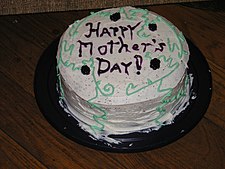This article is about several worldwide days celebrating motherhood. For other uses, see Mother's Day (disambiguation).
| Mother's Day | |
|---|---|
 A homemade cake, one of many ways a family might celebrate Mother's Day, or Mothering Sunday | |
| Observed by | Many countries |
| Type | Commercial |
| Date | Varies regionally |
| Related to | Father's Day, Parents' Day,Children's Day |
The modern Mother's Day is celebrated on various days in many parts of the world, most commonly in May or in March/April, as a day to honour mothers and motherhood. In the UK and Ireland, it follows the old traditions of Mothering Sunday, celebrated in March/April.
Father's Day is the corresponding day for the father.
[edit]Historical antecedents
Lamberts thought[who?] this day emerged from a custom of mother worship in ancient Greece, which kept a festival to Cybele, a great mother of Greek gods.{Encyclopædia Britannica|(1959)Vol.15,p. 849} This festival was held around the Vernal Equinox around Asia Minor and eventually in Rome itself from the Ides of March (15 March) to 18 March.
The ancient Romans also had another holiday, Matronalia, that was dedicated to Juno, though mothers were usually given gifts on this day.
In Europe there were several long standing traditions where a specific Sunday was set aside to honor motherhood and mothers such asMothering Sunday. Mothering Sunday celebrations are part of the liturgical calendar in several Christian denominations, including Anglicans, and in the Catholic calendar is marked as Laetare Sunday, the fourth Sunday in Lent to honour the Virgin Mary and your "mother" church (the main church of the area). Children and young people who were "in service" (servants in richer households) were given a day off on that date so they could visit their families (or, originally, return to their "mother church). The children would pick wild flowers along the way to place them in the church or to give them to their mothers as gifts.[1]
One of the early calls to celebrate Mother's Day in the United States was the "Mother's Day Proclamation" by Julia Ward Howe. Written in 1870, it was a pacifist reaction to the carnage of the American Civil War and the Franco-Prussian War. The Proclamation was tied to Howe'sfeminist belief that women had a responsibility to shape their societies at the political level.
International Women's Day was celebrated for the first time in 28 February 1909, in the US,[2] by which time Anna Jarvis had already begun her national campaign in the US. It is now celebrated in many countries on March 8.
[edit]Spelling
In 1912, Anna Jarvis trademarked the phrases "second Sunday in May" and "Mother's Day", and created the Mother's Day International Association.[3][4]
"She was specific about the location of the apostrophe; it was to be a singular possessive, for each family to honour their mother, not a plural possessive commemorating all mothers in the world."[3]
This is also the spelling used by U.S. President Woodrow Wilson in the law making official the holiday in the U.S., by the U.S. Congress on bills,[5][6] and by other U.S. presidents on their declarations.[7]
Common usage in English language also dictates that the ostensibly singular possessive "Mother's Day" is the preferred spelling, although "Mothers' Day" (plural possessive) is not unheard of.
[edit]Dates around the world
As the US holiday was adopted by other countries and cultures, the date was changed to fit already existing celebrations honouring motherhood, like Mothering Sunday in the UK or theOrthodox celebration of Jesus in the temple in Greece. In some countries it was changed to dates that were significant to the majority religion, like the Virgin Mary day in Catholic countries, or the birthday of the daughter of the Prophet Muhammad in Islamic countries. Other countries changed it to historical dates, like Bolivia using the date of a certain battle where women participated.[8]See the "International history and traditions" section for the complete list.
Note: Countries that celebrate the International Women's Day instead of Mother's Day are marked with a dagger '†'.[clarification needed]
sumber:wikipedia











Tidak ada komentar:
Posting Komentar